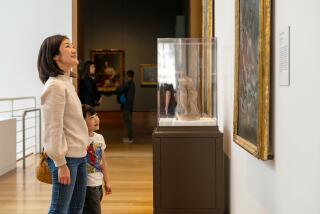Is U.S. Latino Museum bid in horse race with immigration museum?
The already difficult path to creating a National Museum of the American Latino has gotten bumpier because of another museum proposal now pending before Congress – this one aiming to establish a national museum in Washington, D.C., dedicated to the entire immigrant experience.
Backers of the National Museum of the American People want Congress to authorize creation of a presidentially appointed commission to study its feasibility – a first step that the national Latino museum completed in 2011.
The American People museum would look at how all ethnic or national groups came here, ending with 21st century arrivals and starting with prehistoric times when the ancestors of Native Americans traversed an Ice Age land bridge between Siberia and Alaska and became the first humans in the Western Hemisphere.
CHEAT SHEET: Fall arts preview
The two proposals are not precisely rivals, since Congress conceivably could OK both museums. But Estuardo Rodriguez, executive director of Friends of the National Museum of the American Latino, says it won’t help to have another major museum on the Capitol agenda.
“I think it mixes the messages,” he said. “I think there’s going to be a challenge, as it relates to educating the Hill and the supporters we need about the distinctions and differences between these efforts. They are huge and important. We don’t speak critically of [the American People museum] but we make the distinctions clear.”
Latinos’ immigration stories would be covered at both museums, but the Latino museum would go beyond the arrival saga to delve fully into Latino Americans’ history and culture.
A bill now before Congress calls for authorizing the next major preliminary step for the Latino museum: allowing the Smithsonian Institution to “become the owner of this initiative,” as Rodriguez puts it, and conduct a detailed study on whether and how to establish it under the Smithsonian umbrella.
ART: Can you guess the high price?
That would include a close look at a key recommendation from the Latino museum’s 2011 presidential study commission, identifying the Arts and Industries Building, an unused, 132-year-old structure on the National Mall, as the best site and calling for renovations and additions estimated at $400 million to $600 million.
Sam Eskenazi, a retired former staff member of the United States Holocaust Memorial Museum in Washington, is heading the Coalition for the National Museum of the American People. He said this week that it would be built and operated strictly with private funding. That could be a selling point given pressures in Congress to rein in spending.
The Latino museum’s backers envision it will get the same kind of federal support as other Smithsonian museums, including taxpayer funding for half the construction cost and 40% of an annual operating budget estimated at $47 million.
The American People museum “is not a reaction to or in any way related to the proposed American Latino museum,” Eskenazi said. “There’s no reason there couldn’t be two museums.”
He and Rep. Jim Moran (D-Va.), who’s backing the immigration museum, announced this week that there’s bipartisan support from a number of ethnic caucuses in the House, including those for Native Americans and German, Greek, Italian, Korean, Polish, Ukrainian and Vietnamese Americans.
Eskenazi said he’s sought backing among Latino groups, “but they were asked not to support this until the Latino museum made more headway.”
Rodriguez and his group have been mustering support for the Latino museum in a series of informational “town hall” meetings around the country, hoping constituents’ awareness will translate into the votes needed in Congress to push the museum forward. He said one is planned at USC in December.
A Latino museum would be the third Smithsonian history and culture museum devoted to an ethnic or racial group, following the National Museum of the American Indian, which opened in 2005, and the National Museum of African American History and Culture, now under construction and due to open in 2015.
“Where we’re coming from is that you can’t talk about United States history without talking about the [Latino] part in building the country,” Rodriguez said. “It’s not because we want equality” with the other groups that have museums, “but because it’s part of American history and we want to tell the complete story.”
ALSO:
Commission recommends museum honoring U.S. Latinos
La Plaza stumbles as push for national museum gains footholdBackers of American Latino national museum push bill in Congress
More to Read
The biggest entertainment stories
Get our big stories about Hollywood, film, television, music, arts, culture and more right in your inbox as soon as they publish.
You may occasionally receive promotional content from the Los Angeles Times.







